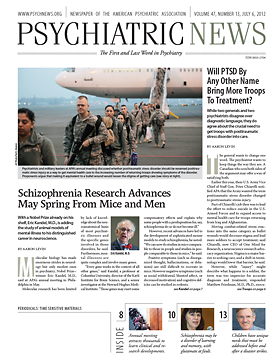Psychosis may be essentially a disorder of learning and memory mediated by impaired glutamate signaling in the hippocampus, causing disruptions in synaptic encoding of memories, said Carol Tamminga, M.D., who delivered an APA Distinguished Psychiatrist Lecture at APA’s 2012 annual meeting in Philadelphia.
This model for understanding psychosis has important implications for treatment, she said. Tamminga is a professor and chair of the Department of Psychiatry and chief of translational neuroscience research in schizophrenia at the University of Texas Southwestern Medical School.
In her lecture, titled “Schizophrenia as a Learning and Memory Disorder,” Tamminga provided an overview of the hippocampus and its principal role in modulating memory and learning. She noted that scientists first became interested in exploring this role in the 1950s when Henry Gustav Molaison, an epilepsy patient, had his hippocampus removed in an effort to cure his seizures. In fact, Molaison’s seizures ceased, but he was left without the ability to form memories; he could retain working memory for 10 to 15 memories but was unable to encode declarative memory.
Tamminga outlined the most recent research using hippocampal imaging studies in schizophrenia to identify specific alterations relevant to learning and memory, especially involving the CA3 region of the hippocampus; the latter, she said, normally allows the brain to “scroll through past memories” and form associations with the present. But in patients with psychosis, there appears to be an increase in baseline blood perfusion and decreases in task-related activation.
“Our model for psychosis is that increased CA3 associational activity generates mistakes of association, which are laid down in memory despite their psychotic content,” Tamminga said. In other words, overactivation in the CA3 region may cause the brain to form spurious associations that get encoded as memories.
“Once your hippocampus makes these mistaken associations, we have no way to check our associations to see if they are correct before they are simply laid down in memory as psychotic content,” she said.
Moreover, this model of psychosis as a disorder of learning and memory mediated by impaired glutamate signaling in the hippocampus appears to account for all forms of psychosis—whether it appears in schizophrenia, bipolar disorder, or epilepsy.
The model was outlined in the article “Glutamate Dysfunction in Hippocampus: Relevance of Dentate Gyrus and CA3 Signaling,” which appeared online April 24 in Schizophrenia Bulletin.
“Hippocampal imaging studies in schizophrenia have identified two alterations in the medial temporal lobe—increases in baseline blood perfusion and decreases in task-related activation,” Tamminga and colleagues wrote. “These observations along with converging postsynaptic hippocampal protein changes suggest that homeostatic plasticity mechanisms might be altered in schizophrenia hippocampus. If hippocampal pattern separation is diminished due to partial dentate gyrus failure (resulting in ‘spurious associations’) and also if pattern completion is accelerated and increasingly inaccurate due to increased CA3 associational activity, then it is conceivable that associations could be false and, especially if driven by anxiety or stress, could generate psychotic content, with the mistaken associations being laid down in memory, despite their psychotic content, especially delusions and thought disorder.”
During her lecture at the annual meeting, Tamminga emphasized that the model has important implications for treatment. These include use of cognitive-behavioral therapy, cognitive remediation, or “brain training” exercises; pharmacologic treatments to decrease excitability in the CA3 region, including dopamine antagonists and cholinergic agonists; and transcranial magnetic stimulation or other forms of neuromodulation.


